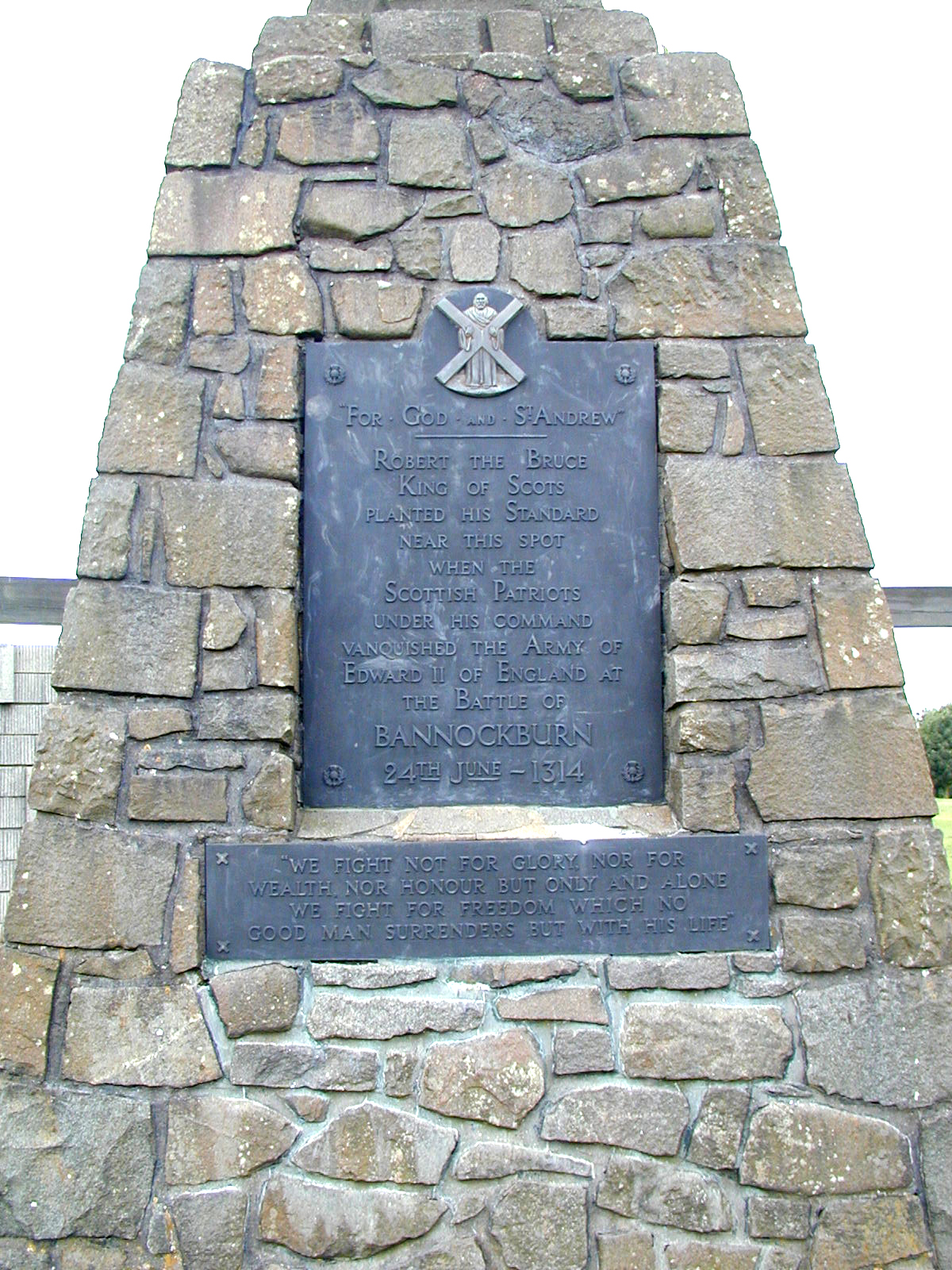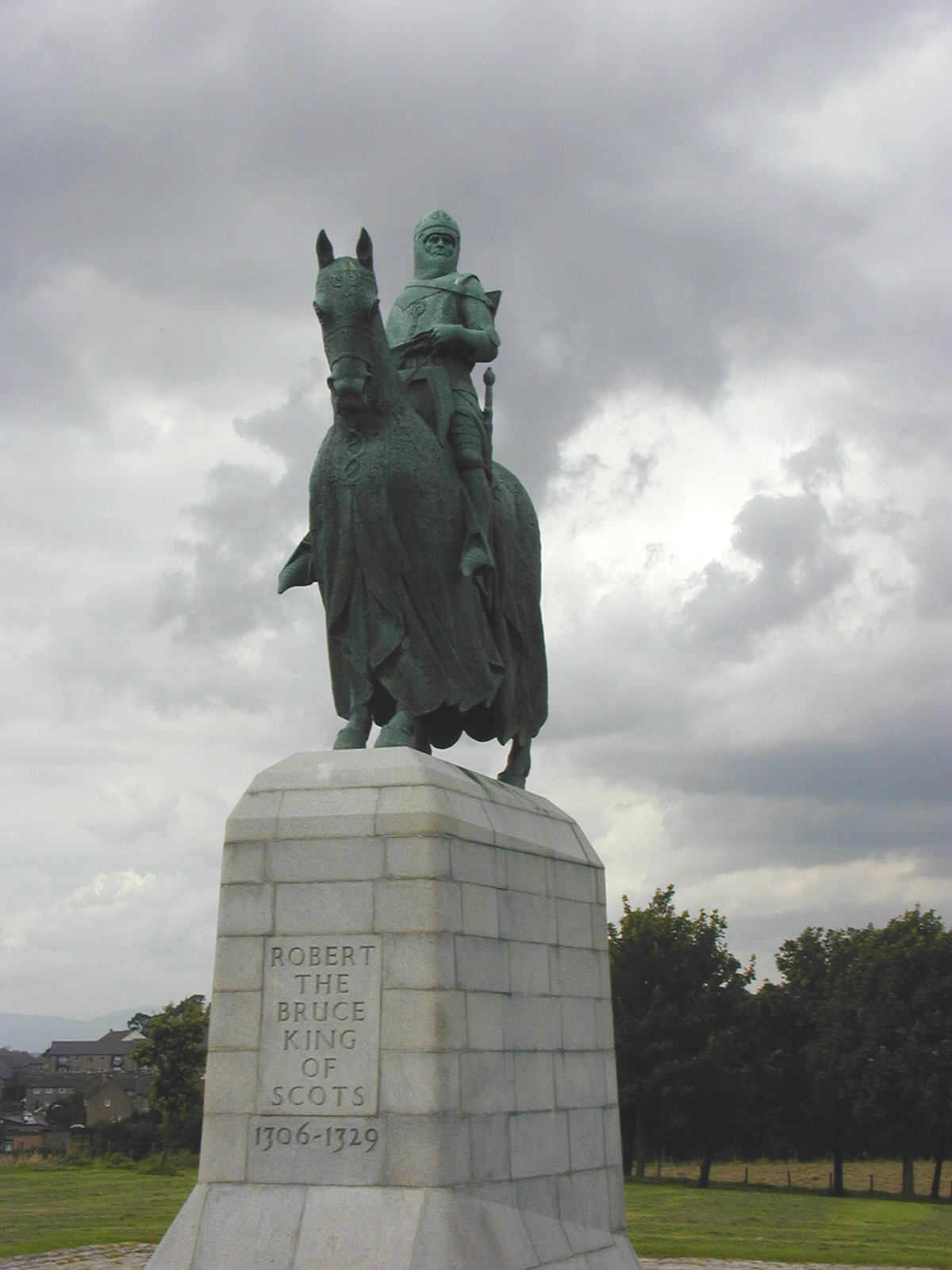|
With the 700th Anniversary of the Battle of Bannockburn just a year a way, we asked our good friend and former contributor, David Caldwell, to write us an article about some aspect of theFormerly Keeper of Scotland and Europe, National Museum of Scotland battle to get everyone in the right mental set for what will hopefully be a major event in Scotland and maybe among Scottish Americans and their friends here in the US. As always, David didn't let us down and here is his piece for this month's Scotia News..
Bannockburn 1314
by David H Caldwell
Formerly Keeper of Scotland and Europe, National Museum of Scotland
On Sunday 24 June 1314  a large army of Scots, perhaps about 20,000 strong, stood in four large units at Bannockburn, near Stirling. There was also a small group of horsemen and some archers but it was the four units or battles which were most striking. All the men, including the greatest in the land and many who in the past would have been reckoned to lowly or poor to have participated in the defense of the realm, armed with long spears. Opposite them was one of the most potent war machines of the Medieval Period, a full English army led by the king, Edward II, in person. Its main strength was a formidable force of heavily armored warriors or knights on large war horses who could be expected, on the basis of past experience, to sweep aside any footmen who opposed them a large army of Scots, perhaps about 20,000 strong, stood in four large units at Bannockburn, near Stirling. There was also a small group of horsemen and some archers but it was the four units or battles which were most striking. All the men, including the greatest in the land and many who in the past would have been reckoned to lowly or poor to have participated in the defense of the realm, armed with long spears. Opposite them was one of the most potent war machines of the Medieval Period, a full English army led by the king, Edward II, in person. Its main strength was a formidable force of heavily armored warriors or knights on large war horses who could be expected, on the basis of past experience, to sweep aside any footmen who opposed them
Remarkably, the Scots neither stood their ground nor attempted to flee. Instead, they advanced in good order at a steady pace towards their enemy. The English cavalry charge against them was ineffective and soon the English were in disarray, increasingly packed together, both horses and knights slaughtered by the Scottish spears. There was no opportunity to bring into action their own foot soldiers, many armed with the bows which were to prove so devastating on later battlefields. The English plight rapidly descended into a rout, a major catastrophe, their king only escaping with difficulty, while many of the other leading men and nobles were either killed or captured.
The battle of Bannockburn was truly a remarkable victory for the Scots and it was down to the leadership of their king, Robert Bruce. On that day nearly 700 years ago the sensible course of action would have been not to fight, but to withdraw his army before first light and to resort to guerrilla tactics. By forcing Edward II to oppose him with a full army he had already achieved a great deal and might have expected to continue his war of attrition over many years to come. But Bruce had confidence in his men, and they equally had enormous faith in him. A few years back in 1298, immediately prior to a disastrous loss at Falkirk at the hands of the English King Edward I, the Scottish commander, William Wallace, is said to have remarked that he had brought his men to the ring, but now it was up to them to see if they could dance. Indeed they did not, not because they could be accused of any cowardice or lack of resolve, but because they were neither positioned nor trained to deal with the formidable enemy in front of them. Many of the survivors of Falkirk leveled their spears at Bannockburn in 1314 but then, no doubt with rather different emotions and expectations than those they held on the previous occasion.

Why was that the case? First and foremost that was down to Bruce himself. Despite, or perhaps because of, disasters earlier in his career, he had turned himself into a great war leader with a sound grasp of strategy and tactics, and the right mix of boldness and caution. He was clearly a man who inspired his followers, one in whom they placed their trust. He had come to a clear understanding of how to defeat the English and had produced a fighting force that was second to none. Beating the English and removing them from Scotland involved wining the hearts and minds of all the Scottish people, the recapture of castles and towns, the waging of guerrilla warfare as well as the ability to successfully oppose English armies on the battlefield.
To do the latter Bruce had to devise tactics to deal with the English heavy cavalry and his approach was twofold. First of all he had to create an army of well trained and skilled men. The Scots had relied in warfare on the service provided by nobles and landowners, obliged to turn out in defense of the realm as a condition of their land tenure, along with the "free service" provided by the adult male population. The resulting armies included many who were not well armed or trained and recent experience had shown that they were often found wanting when faced with the might of the considerably more professional English forces. Bruce did have access to professional warriors, those supported by the militarized society of the Western Isles, and he relied heavily on them from 1306. He also drilled and trained his men from this date. In 1314 he appears to have had forces in place near Stirling by the end of May, getting them ready for the battle to come
Bruce knew he could not produce a force of heavy cavalry to match the English. Instead he had to rely on men who fought on foot, mostly with relatively little armor. He saw that if they were provided with long spears and were trained to fight together in large units then they could be a formidable challenge to cavalry. It is clear that Bruce did not just enroll anybody who had a spear but selected those who were good enough from a much larger pool. Thus at Bannockburn there was a large contingent of men who had not been selected to join the ranks but who were assigned to look after the baggage train, safely hidden away prior to the commencement of hostilities. Famously, in their excitement at seeing their compatriots achieve results in the battle, they came rushing towards the scene and were disastrously mistaken by the English, already teetering on the edge of collapse, for fresh units of fighting men.
Secondly, Bruce had to devise battlefield tactics that would allow his forces to perform well but which would restrict the ability of the English. He may have witnessed the disaster at Falkirk with his own eyes and would certainly have talked to many who were there. He had many other fighting experiences of his own to draw on, as well, clearly as knowledge of the battle of Courtrai in modern day Belgium in 1302 in which a force of Flemings routed the cavalry of the French. From Courtrai in particular Bruce would have learned that it was possible for spear-men to fend off cavalry charges and the full force of those charges could be minimized by careful choice of ground
Bruce first put his battle-winning ideas into practice in a relatively minor battle at Loudoun Hill in Ayrshire in 1307 where his small force of a few hundred men was opposed by the English cavalry commanded by Aylmer de Valence, a force perhaps of about 500. Bruce had selected the men who were to fight, chose his ground well in advance and dug ditches, arranged in such a way that they would restrict the width of the English charge and slow it down. Marshes on both sides of his position meant his army could not easily be outflanked. The result was a stunning victory that demonstrated for the first time that Bruce had the potential to lead his countrymen to victory in the long running struggle against subjection by the English.
In June 1314 it appears that Bruce intended to repeat the winning tactics of Loudoun Hill. He had to oppose Edward II getting through to Stirling Castle and positioned the unit of men led by himself in person across the most likely English approach. This time, rather than ditches, he had pits, containing stakes, dug to restrict and hinder the English charge, and relied on adjacent woods to protect his rear. Interestingly, the men under Bruce that day included those who had made up his army at Loudoun Hill. The English, forewarned, did not attempt a frontal attack on Bruce's position, though Bruce was able with a single blow to inspire his men and sow consternation amongst his foe.While Bruce was astride a small pony in front of his men, standing his ground, an English nobleman, (the evidence suggests it was Sir Henry de Boun), charged at him, and was killed by the Bruce's battle-axe.
Something else happened that day which was much more remarkable than Bruce's defeat of de Boun. One of the other Scottish units, led by Bruce's best general, Thomas Randolph, Earl of Moray, was caught in open ground by English cavalry. Not only did Moray maintain his ground against sustained attack for a considerable length of time, but he was able to see his attackers off. Now Bruce had the evidence that his men did not have to rely on carefully prepared defensive positions but could take the fight to the English. That is exactly what he decided to do the next day.
The battle of Bannockburn did not immediately lead to the capitulation of the English, but there can be no doubt that it was the major turning point in a long struggle that brought freedom and recognition under Bruce's leadership. It has inspired and influenced all succeeding generations of Scots and has rightly been seen as a great example of leadership by a very accomplished general. Although the Scottish spear-men were to win other stunning victories, notably at Byland in Yorkshire on 20 October 1322 under Bruce's leadership, it was, ironically, the English who learned most, discarding their reliance on heavy cavalry in favor of bowmen who were to prove so deadly on many battlefields in Europe as well as Scotland.
This article is based on research published by the author in 'Scottish Spearmen, 1298-1314: An Answer to Cavalry', War in History 19/3 (2012), 267-89.
TABLE OF CONTENTS
PAGE TWO
|